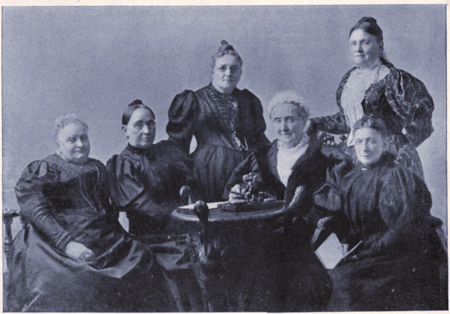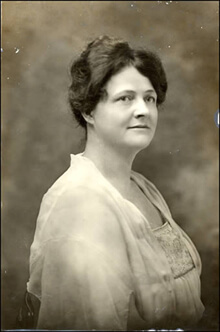Within the life of Methodism, women have been the backbone of ministry. While they are often not front and center in the historical narratives, Wesleyan history always notes the women who have tirelessly exhorted, preached, served, and loved throughout the ages of the Methodist movement. The theological framework of the Methodist tradition drew women naturally into it, as it promoted sanctification through a variety of personal and public piety, as well as social holiness and public witness. In these spheres of justice and mercy, women tapped their natural inclinations of what Frances Willard called “mother-heartedness.” These emotional connections to humanity created a space for women to expand their ministry beyond domestic life and into the public sphere, attaching their theology to their physical capabilities.
50th Anniversary blog series:
Laywomen have been the driving force behind some of the most innovative evangelism and mission work in the denomination through the organizational ways of the Women’s Foreign Missionary Society (WFMS). Women fundraised in creative ways to encourage participation in the full life of the Church, encouraging other women to contribute in their best ways possible from time, labor, or finances. WFMS’s objective was to expand missional offerings beyond that of the missionary’s wife alone, encouraging women to acknowledge “God’s voice as speaking to us – for who can so well do this work as we?” WFMS launched women missionaries to the far ends of the globe and with an entrepreneurial spirit, while local advocates canvassed everyone they knew for support and to publicize the work of Methodist women in mission. Their hope became empowerment and emboldening of women and children within family systems across the world, by encouraging Christian growth and bringing hope to oppressed and marginalized peoples. The creation of the WFMS led to other parachurch organizations that encouraged women’s participation, including the Woman’s Christian Temperance Union (to advocate prohibition), the Young Women’s Christian Association (to advocate antiracism and fight poverty), and even organizations that became heavily involved in the local area’s politics to advocate for woman’s suffrage, antiracism, and education for all people. (1)

Founders of the Woman's Foreign Missionary Society: Mrs. Thomas Rich. Mrs. E. W. Parker. Mrs. Thomas Kingsbury. Mrs. William Merrill. Mrs. William Butler. Mrs. Lewis Flanders. (Courtesy: Wikipedia)
With the success of their missional undertakings, women then took their collective organizing and worked to tackle the problem of women’s representation within the denomination’s decision-making body, the General Conference. Within the ten years of WFMS’s initial operation, there were still no women serving General Boards, Agencies, or the General Conference. Instead, women served the Church in separate spheres than men, where their efforts were successfully funded and sanctioned by the denomination, but their leadership was left out of the larger body. The body’s Discipline solely referred to the laity as laymen, often precluding women’s participation in elections to representative bodies. They began petitioning as soon as the 1880s, and they garnered significant support. However, whenever the matter appeared before the body, it got voted down in reference to the Discipline’s male language. In 1888, four women were elected by their conferences to the General Conference to serve as delegates (and seventeen of them as reserve delegates), but they were denied their seats, referring once again to the male-specific language of the Discipline. Women continued to fight for their representative rights in the denomination, finally earning their recognition as included within the body of the laity in 1904. For the Methodist Episcopal Church South, women’s representation would take even longer, and women would finally be granted the right to representation if duly elected during the MECS General Conference in 1918. The representation of women in the highest decision-making bodies provided healing to those women who had been fighting for so long, while also providing hope for a greater impact to society with the inclusion of women’s voices toward the trajectory of the denomination. (2)

Jessie Daniel Ames (Courtesy: Center for the Study of Southern Culture at University of Mississippi)
Laywomen in the Methodist connection have continually advocated for antiracist policy to bring hope and healing to racially-marginalized communities, especially in the twentieth century. In 1930, a group of women, led by Jessie Daniel Ames, gathered to form the Association of Southern Women for the Prevention of Lynching. They drafted a statement as a foundation for the Association: “Lynching is an indefensible crime. Women dare no longer allow themselves to be the cloak behind which those bent upon personal revenge and savagery commit acts of violence and lawlessness in the name of women. We repudiate this disgraceful claim for all time.” By 1937, their organization branched into 109 organizations with more than four million participants. These Methodist laywomen engaged in antiracist behavior inside the church, as well. Prior to the 1939 Plan of Union that produced The Methodist Church, Southern Methodist women protested the creation of a segregated denomination. In 1936, during the 27th Annual Woman’s Missionary Council meeting in the MECS, the Committee on Interracial Co-operation Study Group presented their opposition to the upcoming plan of union, suggesting the planning commissions “did not make provision in the plan for more direct relationship between white and [Black] Annual Conferences and white and [Black] local churches.” In 1952, the Woman’s Division issued a charter on human rights, applicable to all Woman’s Division organizations and events, and encouraged for all Methodists in the connection. The charter stressed racial equality and compelled all Methodists to refuse to discriminate based on race, while also working to “enable the full participation of any racial group in any phase of the assembly program” on Methodist Assembly grounds. By affirming the whole person and their rights to full access to the Church, Methodist laywomen provide healing to those excluded and gave hope to their fellow Black Methodists that their voices were valued. (3)
Education was a direct outlet for women to enter in the seventeenth and eighteenth centuries. Methodist laywomen engaged in multiple educational fronts for a variety of purposes. Many women launched training centers and Bible institutes for vocationally-called women so that they had ample opportunities for educating themselves and those within their homes and communities. Women also founded schools across the United States and throughout the world as a way to provide education to those who had little access to resources. One of the most famous Methodist educators is Mary McLeod Bethune, who became Methodist simply because they offered her a partnership opportunity. Bethune was seminary-trained and a graduate of Moody Bible Institute when she was preparing to take mission to Africa, but her denomination did not approve her application. After a while of visiting various educational training grounds, including that of Tuskegee Institute, she moved to Florida to establish a school for Black girls, and the Methodist Episcopal Church offered her financial support to open the Daytona Normal and Industrial Institute in Fall 1904. Eventually, she merged her school with the Cookman Institute, and became the first president of the Methodist-affiliated Bethune-Cookman Institute. As a delegate to the General Conference, she served as a member of the Methodist Board of Education and continually pushed the denomination to extend its ministry in education, as she had seen its positive impact in communities. (4)

Mary McLeod Bethune (Courtesy: National Park Service)
Incredible laywomen have also served for the entirety of the General Commission on the Status and Role of Women’s fifty years. From board members to general secretaries to participants, laywomen have impacted the commission in ways that many could never have imagined and that cannot be ignored. Laywomen helped establish the very mission under which GCSRW serves the denomination, but they have also assisted in the creation of advocacy ministries that continually challenge the church to move toward the full participation of women in the life of the Church. In all of these ways, they bring healing to those wounded by damaging policies and structures, while seeking to bring hope of greater possibilities to younger generations. In partnership with United Women in Faith, United Methodist women leave an impact of social holiness in a variety of ways in today’s world, from mission to advocacy to ministries of caring. The ministry of laywomen is important to the hope and healing of the world we serve. Into the 21st century, laywomen stand on the shoulders of those who have served the denomination and the world before, affirming the great cloud of women witnesses, who acknowledged their calls to justice and mercy and boldly and faithfully marched forward to make their communities and their world a better place.
References:
(1) The Women’s Foreign Missionary Society eventually became The Women’s Division of Christian Service, the predecessor to United Methodist Women, which is now named United Women in Faith as of March 2022; “An Appeal to the Ladies of the Methodist Episcopal Church,” The Heathen Woman’s Friend 1, no. 1 (June 1869): 1–3.
(2) Rosemary Skinner Keller, “Creating a Sphere for Women,” in Women in New Worlds: Historical Perspectives on the Wesleyan Tradition, ed. Hilah F. Thomas and Rosemary Skinner Keller, vol. 1, 2 vols. (Nashville: Abingdon, 1981); Virginia Shadron, “The Laity Rights Movement, 1906-1918,” in Women in New Worlds: Historical Perspectives on the Wesleyan Tradition, ed. Hilah F. Thomas and Rosemary Skinner Keller, vol. 1, 2 vols. (Nashville: Abingdon, 1981).
(3) “Ames, Jessie (1883-1972): Lynching Is An Indefensible Crime,” History of Missiology: Boston University School of Theology, February 21, 2020, https://www.bu.edu/missiology/2020/02/21/ames-jessie-1883-1972/; “Methodist Women in the South Oppose Segregated Plan of Union,” 27th Annual Report (Woman’s Missionary Council of the Methodist Episcopal Church, South, 1937 1936); “Woman’s Division Issues Charter on Racial Policies,” 12th Annual Meeting (Buck Hill Falls, Pennsylvania: Woman’s Division of Christian Service, January 8, 1952).
(4) Clarence G. Newsome, “Mary McLeod Bethune As Religionist,” in Women in New Worlds: Historical Perspectives on the Wesleyan Tradition, ed. Hilah F. Thomas and Rosemary Skinner Keller, vol. 1, 2 vols. (Nashville: Abingdon, 1981).

About the author
Rev. Emily Nelms Chastain is a PhD student at Boston University, where she focuses on 19th and 20th Century American Christian History and the intersectionality of faith and gender. She earned her B.A. in History at the University of Alabama at Birmingham in 2007 and graduated with an M.A. Religion and M.Div. in 2019 from Claremont School of Theology. She's an ordained United Methodist Deacon in the North Alabama Conference, and entered academia after serving for 9 years within the United Methodist Church where she worked in Connectional Ministries. Emily served as a reserve delegate to the 2016 General Conference and as a delegate for the 2016 Southeastern Jurisdictional Conference. She has served on the GCSRW board since 2016.
